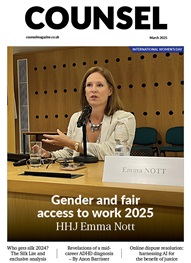*/
Clarity for Lawyers: Effective Legal Language (3rd edition)
Authors: Mark Adler and Daphne Perry
Publisher: Law Society, 270pp
ISBN: 978-1784460488
This a very enjoyable, practical and persuasive guide for any lawyer who wants to improve their use of language. Indeed, as Lord Neuberger writes in his foreword, ‘anyone who is engaged in communication, whether in writing or by word of mouth, could profit from reading this book’.
The book is divided into five parts. It begins by analysing what is wrong with traditional legal writing, using everyday examples and demonstrating how legalese alienates judges, clients and the public. The second part highlights the aims of a legal writer before looking at what exactly plain language is and why it matters. The third part provides practical guidance on how to make your writing more effective, including how to organise and format your documents.
Chapters on key rules of punctuation and grammar include salutary lessons on the effects of getting them wrong: eg ‘For want of a comma, we have this case’ (O’Connor v Oakhurst Dairy, No. 16-901, 1st Cir. 2017). The use of modern computer software is considered. The fourth part of the book analyses how misunderstandings, vagueness, ambiguity, and misleading expectations can all easily be generated. The final part summarises the common law rules of interpretation.
The appendices are helpful; a legal writing workshop, with sample practical exercises in contract drafting; worked examples of revisions being made to solicitor’s correspondence, opinions, etc; and various precedents.
As a Law Society publication, it naturally leans more towards the work of solicitors but barristers will also benefit from the guidance provided.
The US federal judge, Elijah Barrett Prettyman, famously said that ‘the lawyer’s greatest weapon is clarity, and its whetstone is succinctness’ (cited by Herbert F Goodrich, A Case on Appeal – A Judge’s View; Appeals (American Law Institute,1952, p 6). This book will help any lawyer who wants to achieve both.
Reviewer: Michael McParland QC, Commercial Silk at Quadrant Chambers
This a very enjoyable, practical and persuasive guide for any lawyer who wants to improve their use of language. Indeed, as Lord Neuberger writes in his foreword, ‘anyone who is engaged in communication, whether in writing or by word of mouth, could profit from reading this book’.
The book is divided into five parts. It begins by analysing what is wrong with traditional legal writing, using everyday examples and demonstrating how legalese alienates judges, clients and the public. The second part highlights the aims of a legal writer before looking at what exactly plain language is and why it matters. The third part provides practical guidance on how to make your writing more effective, including how to organise and format your documents.
Chapters on key rules of punctuation and grammar include salutary lessons on the effects of getting them wrong: eg ‘For want of a comma, we have this case’ (O’Connor v Oakhurst Dairy, No. 16-901, 1st Cir. 2017). The use of modern computer software is considered. The fourth part of the book analyses how misunderstandings, vagueness, ambiguity, and misleading expectations can all easily be generated. The final part summarises the common law rules of interpretation.
The appendices are helpful; a legal writing workshop, with sample practical exercises in contract drafting; worked examples of revisions being made to solicitor’s correspondence, opinions, etc; and various precedents.
As a Law Society publication, it naturally leans more towards the work of solicitors but barristers will also benefit from the guidance provided.
The US federal judge, Elijah Barrett Prettyman, famously said that ‘the lawyer’s greatest weapon is clarity, and its whetstone is succinctness’ (cited by Herbert F Goodrich, A Case on Appeal – A Judge’s View; Appeals (American Law Institute,1952, p 6). This book will help any lawyer who wants to achieve both.
Reviewer: Michael McParland QC, Commercial Silk at Quadrant Chambers
Clarity for Lawyers: Effective Legal Language (3rd edition)
Authors: Mark Adler and Daphne Perry
Publisher: Law Society, 270pp
ISBN: 978-1784460488


Efforts continue on gender equality, support for the Bar, meaningful reform for the sector and advocating for the rule of law
To mark International Women’s Day, Louise Crush of Westgate Wealth Management looks at how financial planning can help bridge the gap
Casey Randall of AlphaBiolabs answers some of the most common questions regarding relationship DNA testing for court
Leading drug, alcohol and DNA testing laboratory AlphaBiolabs has made a £500 donation to Beatson Cancer Charity in Glasgow as part of its Giving Back campaign
Girls Human Rights Festival 2025: a global gathering for change
Exclusive Q&A with Henry Dannell
Marking Neurodiversity Week 2025, an anonymous barrister shares the revelations and emotions from a mid-career diagnosis with a view to encouraging others to find out more
Patrick Green KC talks about the landmark Post Office Group litigation and his driving principles for life and practice. Interview by Anthony Inglese CB
Desiree Artesi meets Malcolm Bishop KC, the Lord Chief Justice of Tonga, who talks about his new role in the South Pacific and reflects on his career
Sir Nicholas Mostyn, former High Court judge, on starting a hit podcast with fellow ‘Parkies’ after the shock of his diagnosis
Once you submit your silk application, what happens next? Sir Paul Morgan explains each stage of the process and reflects on his experience as a member of the KC Selection Panel